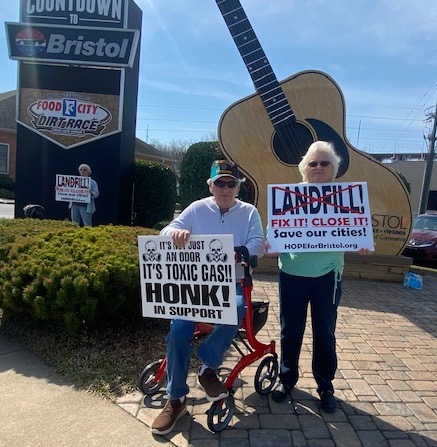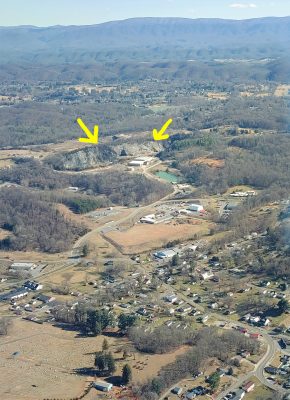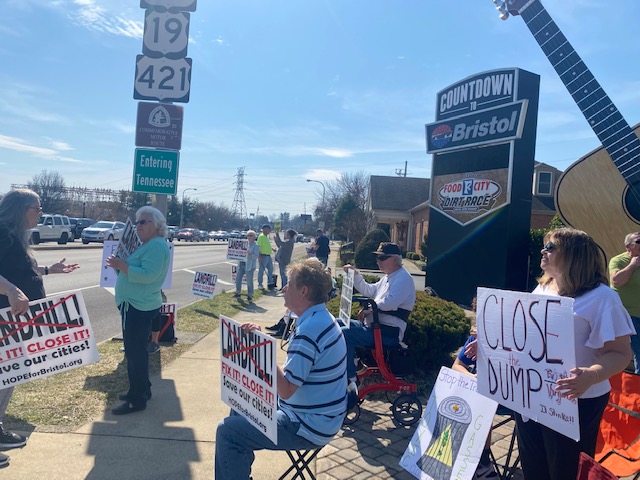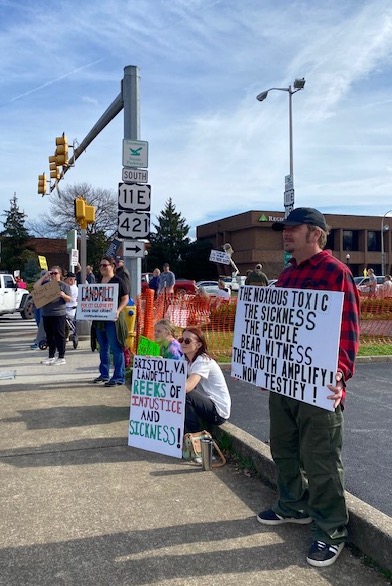The Beast of Bristol: The Landfill Haunting Residents of the Twin Cities

Residents regularly rally in front of the Bristol Chamber of Commerce to protest the ongoing smells from the landfill. The events are organized by HOPE for Bristol. Photo courtesy of Becky Evenden[
By Matt Dhillon
Things have changed in Joel Kellogg’s neighborhood. When he looks around his home on the Tennessee side of Bristol, he can read the subtle signs of a community under siege. There is the plastic over windows and thresholds, the duct tape around the seals of doors, the people carrying canister gas masks. A few blocks away is a house with a skirt of heavy plastic — in most houses, every little crack and vent is found and stuffed with something. As evening approaches, residents hurry into their homes. What they’re trying to keep out usually gets in anyway.
When it comes, it announces itself with its smell.
“There’s notes of, just, rotten produce, garbage, feces, death,” Kellogg says. “I don’t know if you’ve smelled a rotting corpse before, we get a lot of that. There’s also chemical smells that are sweet.”
Such is the signature of what residents have dubbed the Beast, “with a capital B,” as Kellogg says. That’s what locals call the burning, nauseating fumes that have plagued Bristol for at least a year.
The smell lingers after the Beast passes.
“There is no getting away from it,” he says. “It gets in your home; if you open a closet door or a kitchen cupboard, it’s in there. If you open the trunk of your car, it’s in there. If you open your dryer, it is in there. It gets into everything. It gets into your clothes. We’re all running around smelling like landfill.”
The Beast creeps out of the Integrated Solid Waste Management Facility on the Virginia side of the city, northeast of Kellogg’s Fairmount neighborhood. It flows with the wind and penetrates the city with nauseating fumes all the way downtown and can range along the I-81 corridor as far as Abingdon, Virginia, and Blountville, Tennessee, according to Kellogg.

This aerial photo from a February 2022 flyover shows mountains in the background, homes in the foreground and the landfill quarry in the middle. Click to enlarge. Photo courtesy of Becky Evenden.
“It will get to the point where people driving down the street will vomit in their cars,” Kellogg says.
When the issue first came to light in late 2020 via local complaints, the affected area was about a two-mile radius around the landfill. Even as it grew stronger, the Beast was contained to stalk the hours of the night. Residents began to anticipate the smell after dark, which was worse because the evening temperatures trapped the gasses. But now, it can come in the daytime, too.
The crowdsourcing smartphone app Smell MyCity recorded 1,993 complaints from the Bristol area in January 2022. Residents frequently reported symptoms like headache, nausea, burning throat and eyes, nosebleeds and difficulty breathing. One complaint reported “existential dread” as a symptom and another noted, “taste it.”
“It’s like a monster. It steals into your home, it takes your health, it takes your breath, it takes your life,” Kellogg says.
Kellogg is the president of HOPE for Bristol, a nonprofit organization founded in September 2021 with the dual purpose of closing the offending landfill and providing relief to those affected by it. Every Saturday since December 11, 2021, the group hosts its Rally for Relief outside of the Bristol Chamber of Commerce and protests outside of Bristol, Virginia’s City Council meetings held on the second and fourth Tuesday of every month.
The City Responds
Bristol Virginia’s City Council, under the leadership of City Manager Randy Eads, has made moves to try to reign in the Beast. In 2021, the city committed $2.8 million in projects and infrastructure to repair or improve the landfill, according to local newspaper Bristol Herald Courier.
The prevailing strategy has been to drill more wells to capture the gasses of decomposition produced under the landfill’s surface and to pump out excess water, since water accelerates the reactions that emit the gas. The previous round of wells were drilled in the landfill in 2016, following the long-term plan, but after complaints came to light in late 2020, another 21 wells have been added to the pre-existing 20, according to the city’s website.
In a November City Council meeting, Eads addressed concerns.
“It smells horrible,” Eads said. “I have never once denied that. This city, since December 17th of [2020], has done everything in its power to resolve this as quickly as possible. We immediately called in the experts when we knew this was a bigger situation than we’d ever had in the past.”
He added, “We have taken the steps we need to take to solve the problem, it just takes time to fix it.”

Holding both pre-printed and homemade signs, residents make their displeasure with the landfill fumes known. Photo courtesy of Becky Evenden.
Residents Act
But the members of HOPE for Bristol do not think the city has done enough and are skeptical of the proposed solution. A community-run Facebook page about the issue with approximately 6,500 members continues to fill up with concerns as well. A prevailing concern is getting officials to recognize that the problem is more than just a stinky nuisance — residents say that noxious emissions are polluting their air and endangering their health.
Becky Evenden, a co-founder of HOPE for Bristol and former chemical engineer, recalls difficulty in getting officials to address the seriousness of the issue when she started seeing problems early in 2021. Evenden was concerned that there was a subsurface heating event happening in the landfill, which happens when the heat trapped in a landfill begins a self-propagating thermal reaction under the surface. Unlike a fire, this is a chemical reaction that can happen in the absence of oxygen and in the presence of water. Indicators of such an event include a foul odor, the release of toxic gasses including carbon monoxide and benzene, and reports of symptoms, by now familiar to the city, such as headaches, nausea, fatigue, nosebleeds and burning in respiratory passages. Things were starting to line up for Evenden.
So, Evenden kept digging, including filing Freedom of Information Act requests for data from the landfill.
“I was sent the well temperature and well monitoring data in April [2021], with the tagline of, ‘hey, we don’t see any elevated temperatures,’” Evenden says. “Well, lo and behold, as I look at the data I see that a number of the wells really have no methane being produced, it’s all carbon dioxide and for me that was just a big clue that there was something wrong with those wells.”
The shift in those gasses is a major indicator of the subsurface heating event Evenden was looking for.
“Within about a week of me asking those questions and saying something’s off in this data, we had the consultants coming forth and saying, [they were finding,] essentially, areas of subsidence where there was just venting — like emissions freely venting from parts of the landfill,” Evenden says. “And then within about 2 months of that discovery, all of a sudden they said, ‘Oh, we have hot temperatures, and actually we had some hot temperatures that we missed all the way back in December.’”
The Bristol landfill is big — it’s the main destination for trash in the region — but it’s not unusually big. The 17-acre site receives an estimated 175,000 tons of mostly municipal waste per year, according to the city’s website, which is less than the 1 million-plus tons taken in annually by the Middle Point landfill in Rutherford county, but much more than the 400 tons that goes to the nearby Sullivan County landfill.
What is different about the Bristol landfill is that the site is repurposed from an old limestone quarry. Quarry landfills are not that common, but they have a history of problems.
The Rockland Landfill in Maine is closing at the recommendation of the state’s Department of Environmental Protection, following odor complaints and a 2011 fire. The Bridgeton Landfill in Missouri, a famous Superfund site, has been burning since 2010. Bristol is the only quarry landfill operating in Virginia, but another that was proposed in Chesterfield County near Richmond was denied in 2018 by the board of supervisors citing concerns of fire hazard.
The problem with quarry landfills is that the bottom is typically well below the water table, as is the case for Bristol, and just like abandoned quarries, they collect groundwater and rainwater. This means that they need more attention and upkeep than ordinary landfills.
“It’s really hard to remove the waste water and ground water from those landfills, and that increased liquid content really accelerates the rate of reactions,” Evenden says. This higher-temperature reaction also puts off a different mixture of chemicals.
The Bristol landfill has leachate and groundwater collection systems deep below the heap on the very bottom of the quarry. But it is difficult to control all of that water, and where oversaturation almost inevitably occurs, it can be the root of a lot of problems. High moisture causes accelerated decomposition. That, in turn, causes heat increases, which cause a variety of gasses to be produced, including carbon monoxide, hydrogen sulfide and ammonia. Those gasses often escape wherever they can and cause foul odors.

A closer aerial view of the 17-acre landfill shows the sides of the quarry, exposed dirt, roads and a nearby building. Photo courtesy of Becky Evenden.
Intent to Sue
City officials have been accused of mismanagement of the landfill leading up to this point. On December 8, 2021, sister city Bristol, Tennessee, sent a Notice of Intent to Sue across the state line to the city manager, Eads, in Bristol, Virginia. The letter identifies several violations to charge against the landfill, including violations of the Clean Air Act and several infractions related to the permitted temperature in the landfill that could have prompted earlier corrective action.
One key question is the exact level of toxic threat the landfill poses. EPA and the Virginia Department of Environmental Quality conducted monitoring in summer 2021, and an initial review concluded that air quality in the city posed no immediate risk to human health. In ongoing reports, EPA On-Scene Coordinator Myles Bartos identified the occurrence of volatile organic compounds at low levels and wrote in January that “The potential threats posed by this Site are currently unknown.” He noted elevated readings of benzene and acrolein, but they were not high enough to trigger a site cleanup by the EPA.
“Of course we’d like to have perfectly clean air with only oxygen, right,” Bartos says of the results. “But I can tell you, when evaluating with the other agencies, it’s not inconsistent with what you might expect to find in urban communities.”
Green Toxicology LLC, a consulting firm hired by Bristol, Tennessee, conducted a separate analysis of this data along with more onsite sampling at five locations at the landfill, and their December 2021 report supported the government’s results. The report identified malodorous chemicals consistent with degrading food waste such as hydrogen sulfide, methyl mercaptan, ammonia, 2-butenal, and again, higher-than-average levels of benzene. However, all concentrations were within established health-based benchmarks.
“The vapors and gasses that are coming off are of a quality and a quantity that is unusually high,” said the firm’s president Laura Green in a January presentation to the public. “Those levels are very smelly, very malodorous, but they’re not toxic. The concentrations are too small.”
Green identified some key problems with the landfill contributing to the smell. “There’s much more [gas] escaping than there ought to be, and then, separately, the leachate collection system is malfunctioning, and there’s this smoldering reaction going on underground,” Green said.

In addition to the noxious smells, residents report headaches, nausea, fatigue, nosebleeds and burning in respiratory passages. Photo courtesy of Becky Evenden.
Can They Just Close It?
The next step, according to Evenden, should be to close the landfill. Other critics of the landfill, including the protesters that come out weekly with HOPE for Bristol, agree. That process would include engineering a clay cap to cover the landfill, drilling new wells to manage venting gasses, and channeling water away from the site.
“Once you get a high temperature in a landfill like that, it may not be possible to slow down that high temperature reaction,” Evenden says. “All you can do is cover and contain. The highest temperature we’ve seen is 200 degrees Fahrenheit, which is pretty high, under some criteria that would be considered an underground fire in a landfill. If you don’t put a cap on top of this thing, you’re never going to control the fugitive emissions and you’re not going to contain the reaction. You’re just adding more fuel to the fire by dumping more waste.”
But whether that method would work is the matter of another debate. Craig Benson, a landfill expert consulted by Bristol, Virginia, has said that capping the landfill now would be a mistake, according to local reporting. Benson expressed that doing so would only add pressure to the smoldering trash and increase temperatures. Added to that is the challenge of managing water if the landfill were to close early and leave a bowl, well below the planned grade.
The city has considered a plan for early closure that estimates capping the landfill in June 2027.
No immediate plans for closure have been made. Bristol, Virginia, officials did not respond to requests for comment, but, in a November address to the Bristol Chamber of Commerce, City Manager Eads emphasized the need to focus on capturing the fugitive emissions and fixing the drainage issues to get the smell under control.
“We have experts on staff that have dealt with these issues, that are telling us what we need to do to fix it, and we have to listen to our experts,” Eads said.
Once that is done, the city may continue to operate the landfill or work toward early closure. At the November meeting, Eads reiterated that the city is doing and will do whatever is needed to get the problem under control and has backup plans ready to go if those measures don’t work. But those plans exclusively involve digging more wells, capturing more gas, and doing more of what they’re already doing, and the timeline for getting it under control keeps getting extended.
Benson suggested that it could be the summer of 2023 before improvements at the landfill are able to quell the smell, according to reporting in the Bristol Herald Courier.
Residents who are still living with the Beast stalking their communities are far from resolved. Complaints on Facebook and Smell MyCity continue to report sickness, headaches and poor health. Many are not convinced the city can manage such a problematic landfill.
“We want this thing closed and we want a cap on it,” Kellogg says. “They need to stop the intake, they need to get a good cap on this thing, a good thick, clay cap with probably a geomembrane cover over that.”
Until that happens, the members of HOPE for Bristol remain alert. The Beast is still out there.
Related Articles
Latest News

Leave a comment
Your email address will not be published. Required fields are marked *





This information I do not believe is accurate. According other medical sources, the chemicals and gases being emitted are already causing symptoms and health issues in nearby residents. That’s proof that it IS INDEED TOXIC AND ALREADY AFFECTING PEOPLE AND COMPROMISING BOTH THEIR PHYSICAL AND MENTAL HEALTH. THAT INTURN COMPROMISES THEIR PROSPERITY AND ABILITY TO LIVE A QUALITY LIFE. THIS IS TYPICAL OF SHALLOW MINDED MONEY MONGERS WHO CAN ONLY SEE DOLLAR SIGNS IN PRSENT TENSE , WHILE FAILING TO SEE AHEAD THE ENORMOUS LAW SUITS THAT WILL BEGIN TO COME , DUE TO THEIR INABILITY TO UNDERSTAND THE COMMON SENSE OF PREVENTION IN THE PRESENT. THEY ARE PUTTING PEOPLE AT SERIOUS RISK FOR CANCER AND DEATH. WHEN WILL PEOPLE EVER LEARN , TO “ NOT WAIT” ,UNTIL A SITUATION BECOMES CATASTROPHIC BEFORE TRYING TO DO SOMETHING BEFORE IT OCCURS??? BY THEN , ITS ALWAYS TOO LATE. “ PREVENTION IS WORTH A POUND OF CURE”…..THAT ALSO APPLIES TO THE WALLET. BETTER TO SPEND NOW , THAN REALLY PAY LATER AND BE PROSECUTED FOR IT AND HAVE INNOCENT BLOOD ON YOUR HANDS AND CONSCIENCE. PEOPLE ARE BREATHING THIS INTO THEIR LUNGS ON A REGULAR BASIS. ACUTE ONNE TIME EXPOSURES ARE GENERALLY STUDIED AND FOUND YO BE NON THREATENING , OR PRESENT THE ABILITY YO RECOVER FROM. HOWEVER, LONG TIME CONTINUOUS EXPOSURE, EVEN IN SMALL AMOUNTS IS MEDICALLY AND SCIENTIFICALLY PROVEN TO LEAD TO CANCER AND DEATH. YOU ARE DEALING WITH THE LUNGS , WATER, SOIL, HUMIDITY AND GASES. BAD , LETHAL COMBINATION TO BE QUICKLY INHALED , ABSORBED INTO THE SKIN AND INGESTED BY DRINKING CONTAMINATED WATER. LUNG CANCER IS THE PRIMARY RESULT FROM INHALING THESE EXACT EMISSIONS. INDIVIDUALS PRESENTING SYMPTOMS ARE IN NO DOUBT ALREADY BEING ADVERSELY AFFECTED.
This is just unbelievable in this day n age.Id think itd be against the law.I moved here from MD.in 2020.I smelled what every ones reported.Ive been sick since moving here.I moved to Country because of the clean mountain air.Report today there isn’t any clean air here.Also when I bought a house no one mentioned to me what that smell is.Not only r we low on mountain air but clean nice honest people also.If moving from city don’t move here.Its awful.And also why is there no law for residents neighbors here to clean yards porches etc.?
stinky smell, the do need to get rid of that thing
Your plight is, I think, not widely known — I stumbled across it after being referred to “Appalachian Voices” by novelist John Grisham in “Gray Mountain”.
The entire Nation needs to get behind a solution : Removal (to where ?) or in-situ Neutralization.
We have some related problems here in Southwest Florida owing to water pollution by fertilizers.
I bought my home in 2010 thinking how happy I was moving to Bristol. Fast forward and now I’m dealing with issues with walking, breathing, upper respiratory infection I can’t seem to get rid of, shortness of breath and lately my fingertips and toes tend to have a purple color. I live about a mile from the dump and the city can’t tell me that these issues are not related to the noxious toxic fumes coming from that thing. I was in good health before I moved here but it has gone downhill since the odors have increased.
I believe that the landfill is unmanageable and that the only solution is excavation and relocation of all the waste. Yes that is a massive project but not impossible. It would be expensive but not as expensive as all the health issues and lawsuits added to the cost of trying to maintain and manage the Beast.
Very good, factual article! We need to use the concern about how to properly dispose of wastes and trash, and need to have recycling in both Bristols, plus the garbage to compost system used in Johnson City. One omissions, however: the situation of the juvenile detention center’s location, on the edge of the landfill, which was never examined when the landfill started. Recent develpments in VA with the envionmental justice group, which includes the Sierra Club, which happened last week here, probably were too late to include in this report. Hoping you can keep reporting on developments in future articles!